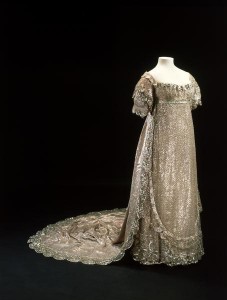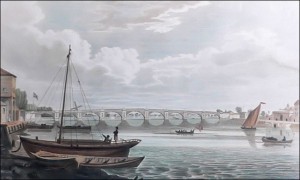Candice’s novella Fate Strikes a Bargain is set in 1816.
All links are to Wikipedia entries.
Government, Politics, and War:
- March 18: The income tax is abolished in Britain (it will be reintroduced in 1842).
- May 22: Littleport and Ely Riots break out in East Anglia as a result of high unemployment and rising grain costs.
- August 27: Britain and the Netherlands bombard Algiers in an attempt to suppress slavery in the North African Barbary states.
- September 5: Louis XVIII of France dissolved the Chamber of Deputies, which had been challenging his authority.
- November-December: Mass meetings organized by radical Spenceans (named after radical Thomas Spence) descend into the Spa Fields Riots. on December 2.

Princess Charlotte’s Wedding Dress at the Museum of London. (Click on image to see a larger version.)
Society and Social History:
- January: Lord Byron’s wife leaves him, taking their infant daughter Ada with her.
- January: Napoleon’s carriage, captured at Waterloo, is displayed at Bullock’s Museum in London.
- May 2: England’s Princess Charlotte marries Prince Leopold of Saxe-Coburg.
- May: In the wake of rumors of marital violence, sodomy, incest, and adultery, Lord Byron leaves England, never to return.
- May 16: George “Beau” Brummell leaves England to escape his creditors, never to return.
- June: Luddites make well-organized efforts to smash machinery in riots at several industrial centers in England.
- July 5: Dorothea Jordan, actress and long-time mistress to the Duke of Clarence (future King William IV), dies at age 54.
- July 7: Playwright and statesman Richard Brinsley Sheridan dies at age 64 .
- December 30: Poet Percy Bysshe Shelley marries Mary Godwin (daughter of Mary Wollstonecraft and William Godwin), only three weeks after his first wife commits suicide by drowning in the Serpentine.
Literature, Journalism, and Publishing:
- Jane Austen’s Emma is published.
- Samuel Taylor Coleridge publishes the poem “Kubla Khan” (though he claims to have first written it in 1797).
- Percy Bysshe Shelley writes Hymn To Intellectual Beauty.
- Lady Caroline Lamb publishes the novel Glenarvon anonymously.
- Lord Byron publishes several important poems this year, including “The Siege of Corinth,” “The Prisoner of Chillon,” and “Prometheus.”
- Poet Thomas Love Peacock publishes his first novel Headlong Hall.
- In London, England, William Cobbett brought out two-penny version of his Weekly Political Register on a single sheet of paper to avoid the stamp duty.
- Lord Byron and friends gather at the Villa Diodati on Lake Geneva, Switzerland, where Byron challenges his guests to write a ghost story. Among the results are two classic Gothic narratives: Mary Shelley’s Frankenstein (published in 1818) and John Polidori’s short story “The Vampyre” (published in 1819).

Vauxhall Bridge shortly after it opened in 1816. Artist unknown. (Click on image to see a larger version.)
Art, Architecture, and Design:
- The British Museum purchases the Elgin Marbles for £35,000 and they become a permanent display.
- The Fitzwilliam Museum is founded by the bequest of the art collection of the 7th Viscount FitzWilliam to the University of Cambridge.
- June 4: Vauxhall Bridge, crossing the River Thames in central London, designed by James Walker, is opened. It is initially named Regent’s Bridge, but almost immediately is renamed Vauxhall Bridge, which is how it was known throughout the planning and building. It will be replaced by the current Vauxhall Bridge in 1906.
Music:
- February 20: Rossini debuts “Il Barbiere di Siviglia” (“The Barber of Seville”) in Rome where it is badly received with much hissing and booing from the audience. The second performance was a rousing success.
Science and Industry:
- A gold medal is awarded to French mathematician Sophie Germain by the Académie Française; she was previously denied the award twice before because of her sex. She is the first woman ever invited to attend sessions at the prestigious Institut de Paris.
- Robert Stirling, British clergyman, proposed a sealed heated air engine to compete with the ubiquitous steam engine. His Stirling engine converted heat into mechanical energy by compressing and expanding a fixed quantity of gas.
- French physician René Laennec invents the stethoscope.
- October 27: Completion of the Leeds to Liverpool canal.
Natural History and Exploration:
- Cold weather persists throughout the summer of 1816 in much of the world’s temperate zones creating the “year without a summer,” especially in North Amerca. The unusual climate is likely due to a major volcanic eruption in Indonesia, and inspires Lord Byron’s poem “Darkness.”
- A British expedition explores up from the mouth of the Congo River.
- August 13: A strong earthquake strikes Aberdeen, Scotland.




